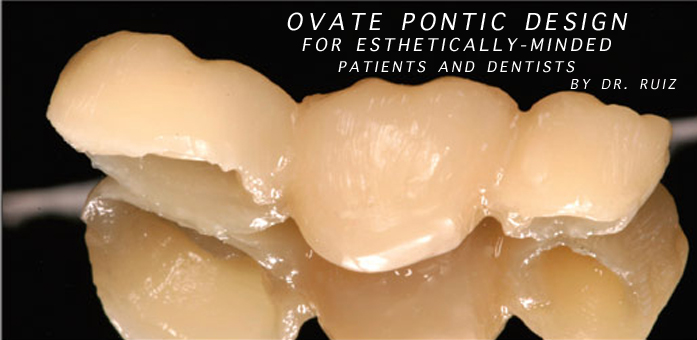
Ever since the cosmetic revolution in the 1980s, dentists have reconsidered the use of the ovate pontic design for teeth replacement. Design, procedure and preparation for ovate pontics does, however, require more time and skill than other options. In his 2006 article, Dr. Jose-Luis Ruiz handles the topic with esthetic expertise, outlining techniques for design, extraction, impression and cementation.
The Pontic Comeback
Dentists had put ovate pontics on the undesirable list sometime in the 1930s under the assumption that the design was unhygienic and would lead to gingival inflammation. However, recent research has disproved the assumption that ovate pontics will cause chronic inflammation when coupled with proper oral hygiene care and its popularity has increased. Dr. Ruiz considers ovate pontics as more hygienic than ridge lap and saddle pontics.
Ovate Pontic Positives
- Esthetic similarity to real teeth can boost self-confidence and lessen social anxiety
- Similar emergence profile of a natural tooth
- Similar lingual contours of a natural tooth
- Positive phonetic experience with closed gaps help prevent passage of air and saliva that often cause embarrassing whistling or slurping
- Possible to use ovate pontics on an immediate extraction site or edentulous ridge
- Hypertrophic ridges can be used as site with assistance of ridge augmentation surgery, GBR or GTR
Technique
Dr. Ruiz reports on proper design technique and stresses the point that design must be a collaborative effort between dentist and technician and specifically cater to patient’s specific needs. With concise step-by-step information, Dr. Ruiz explains in his article the process of ovate pontic placement for immediate extraction and for edentulous ridge preparation. When tissues are healthy, post extraction or edulous ridge augmentation surgery, impressions are made first through standard impression of the prepared teeth and second with the impression of the provisional fixed partial denture. If the impressions have been done correctly the pontic will fit well and create a healthy pressure on the tissue. Cementation will be done with a “standard crown and fixed partial denture cementation” technique and all cement particles should be removed from under the pontic area.
The Ovate Pontic design is ideal for dentists looking to offer patients an esthetically-conscious option for tooth replacement. With proper hygienic care, patients will be able to maintain proper oral health. The best esthetic results will come from dentists who have studied proper design, impression and cementation. For a more detailed look at the procedure, one should refer to Dr. Ruiz’s article published in Oral Health.

